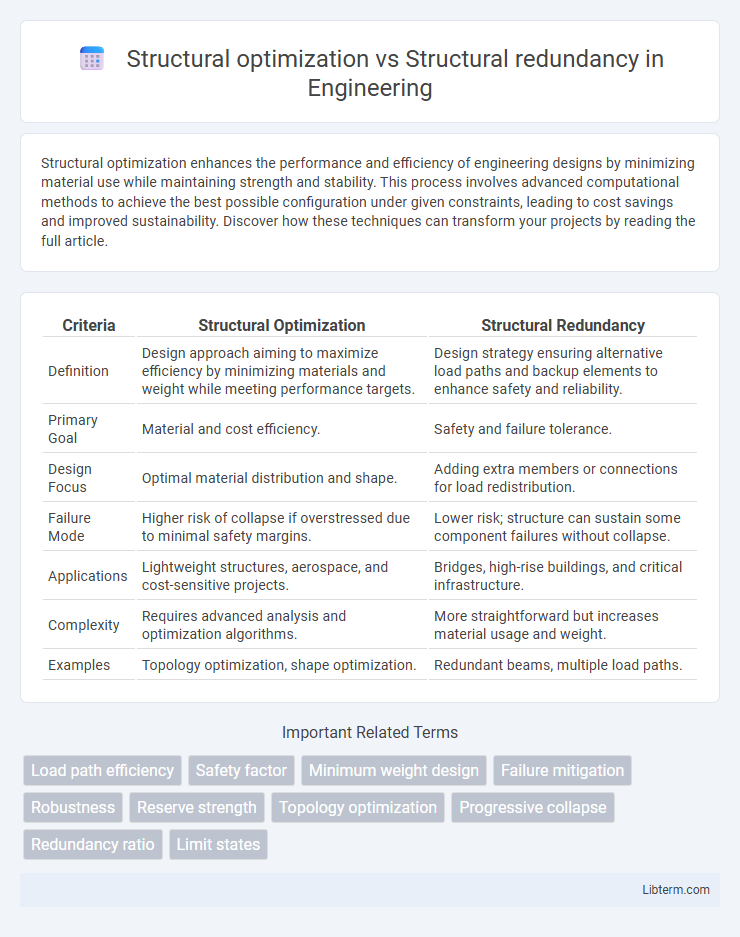Structural optimization enhances the performance and efficiency of engineering designs by minimizing material use while maintaining strength and stability. This process involves advanced computational methods to achieve the best possible configuration under given constraints, leading to cost savings and improved sustainability. Discover how these techniques can transform your projects by reading the full article.
Table of Comparison
| Criteria | Structural Optimization | Structural Redundancy |
|---|---|---|
| Definition | Design approach aiming to maximize efficiency by minimizing materials and weight while meeting performance targets. | Design strategy ensuring alternative load paths and backup elements to enhance safety and reliability. |
| Primary Goal | Material and cost efficiency. | Safety and failure tolerance. |
| Design Focus | Optimal material distribution and shape. | Adding extra members or connections for load redistribution. |
| Failure Mode | Higher risk of collapse if overstressed due to minimal safety margins. | Lower risk; structure can sustain some component failures without collapse. |
| Applications | Lightweight structures, aerospace, and cost-sensitive projects. | Bridges, high-rise buildings, and critical infrastructure. |
| Complexity | Requires advanced analysis and optimization algorithms. | More straightforward but increases material usage and weight. |
| Examples | Topology optimization, shape optimization. | Redundant beams, multiple load paths. |
Introduction to Structural Optimization and Redundancy
Structural optimization involves designing load-bearing systems to achieve the best performance by minimizing weight, cost, or material usage while satisfying safety and functionality constraints. Structural redundancy refers to the inclusion of extra components or pathways within a structure to enhance reliability and ensure load redistribution in case of member failure. The balance between optimization and redundancy is critical in engineering to maximize efficiency without compromising the robustness and safety of the structure.
Defining Structural Optimization: Goals and Methods
Structural optimization focuses on designing structures that achieve maximum performance with minimal material use, cost, and weight while ensuring safety and functionality. Common methods include topology optimization, size optimization, and shape optimization, which employ algorithms and computational models to identify the most efficient design configurations. The primary goals emphasize enhancing structural efficiency, reducing resource consumption, and improving load-bearing capacity without compromising durability.
Understanding Structural Redundancy: Concepts and Benefits
Structural redundancy involves designing multiple load paths within a structure to ensure stability and safety even if one component fails, enhancing overall system reliability. This approach reduces the risk of catastrophic failure by distributing stresses and providing backup support, which is crucial in critical infrastructures like bridges and high-rise buildings. Understanding structural redundancy enables engineers to create resilient designs that balance material efficiency and safety under varying load conditions.
Key Differences Between Optimization and Redundancy
Structural optimization focuses on minimizing material use and weight while maximizing strength and performance, employing techniques such as topology optimization and finite element analysis. Structural redundancy involves incorporating extra load paths or components to enhance safety and reliability by preventing failure when parts become damaged. The key difference lies in optimization aiming for efficiency and cost reduction, whereas redundancy prioritizes robustness and fault tolerance.
Importance of Safety Factors in Structural Design
Structural optimization aims to maximize performance and minimize material use, whereas structural redundancy enhances safety by providing multiple load paths to prevent catastrophic failure. Safety factors are crucial in structural design to account for uncertainties in material properties, load estimations, and environmental conditions, ensuring reliability beyond nominal design limits. Integrating safety factors supports both optimized and redundant structures by balancing efficiency with robustness for long-term durability.
Cost Efficiency: Optimization vs. Redundancy
Structural optimization minimizes material usage and weight to achieve maximum cost efficiency by tailoring designs to specific load conditions, reducing fabrication and maintenance expenses. Structural redundancy, while increasing safety by providing alternate load paths, often results in higher initial costs due to additional materials and complexity. Balancing optimization and redundancy is critical for cost-effective designs that ensure both economic efficiency and structural reliability.
Performance and Reliability Considerations
Structural optimization enhances performance by minimizing material use and weight while maintaining required strength, leading to cost-effective and efficient designs. Structural redundancy improves reliability by providing alternative load paths, ensuring safety and durability under unexpected stresses or component failures. Balancing optimized design with sufficient redundancy is critical for achieving both high structural performance and robust reliability in engineering applications.
Modern Engineering Approaches to Structural Design
Modern engineering approaches to structural design increasingly integrate structural optimization techniques, leveraging computational algorithms to minimize material use while maximizing strength and stability. Structural redundancy, providing multiple load paths to enhance safety and resilience against unexpected failures, complements optimization by ensuring robustness under unforeseen conditions. Balancing these concepts allows engineers to create efficient, cost-effective structures that meet stringent safety standards and sustainability goals.
Case Studies: Real-world Applications
Case studies in structural optimization demonstrate significant material savings and enhanced performance in aerospace and civil engineering projects, such as lightweight aircraft components and efficient bridge designs. Structural redundancy case studies emphasize improved safety and resilience, illustrated by the collapse prevention of Ronan Point apartment tower and robust emergency systems in suspension bridges like the Golden Gate Bridge. Balancing optimization with redundancy in real-world applications ensures cost-effectiveness while maintaining critical structural integrity under unexpected loads or damage.
Future Trends in Structural Engineering
Structural optimization enhances material efficiency and performance by utilizing advanced algorithms and AI-driven design tools, enabling lightweight yet resilient structures. Structural redundancy focuses on incorporating backup load paths to improve safety and durability against unexpected failures, often realized through robust design codes and innovative construction materials. Future trends in structural engineering emphasize the integration of smart materials, real-time monitoring, and machine learning to balance optimized designs with redundancy, ensuring adaptive, sustainable, and safer infrastructure.
Structural optimization Infographic

 libterm.com
libterm.com